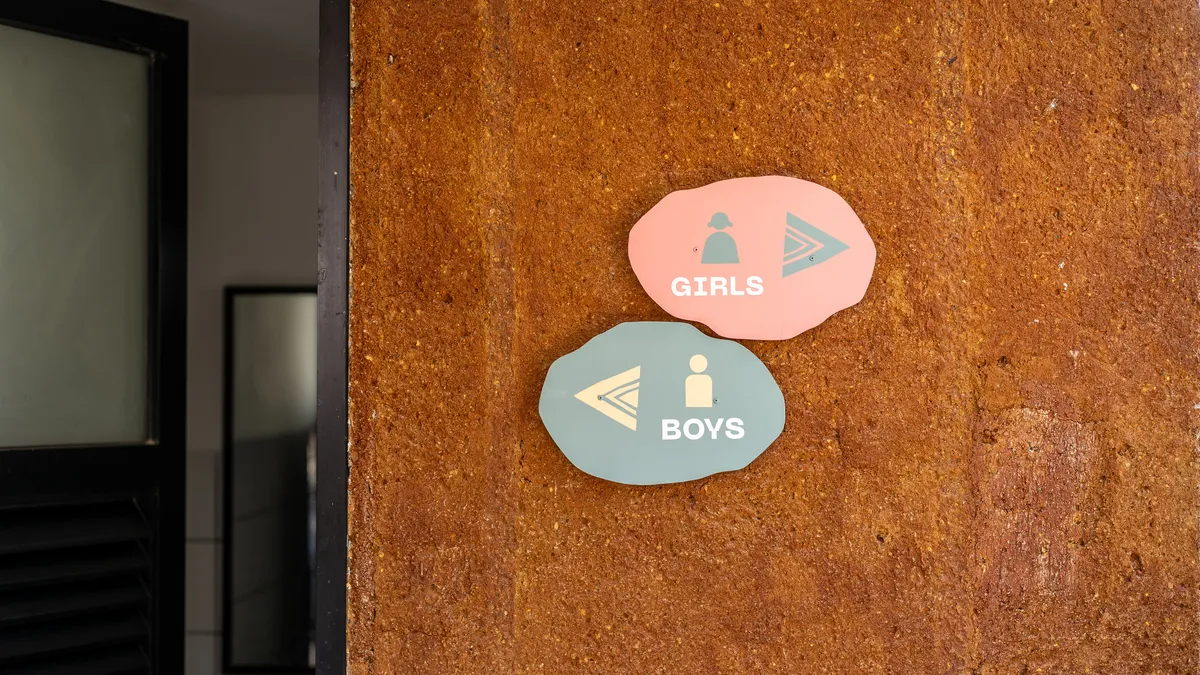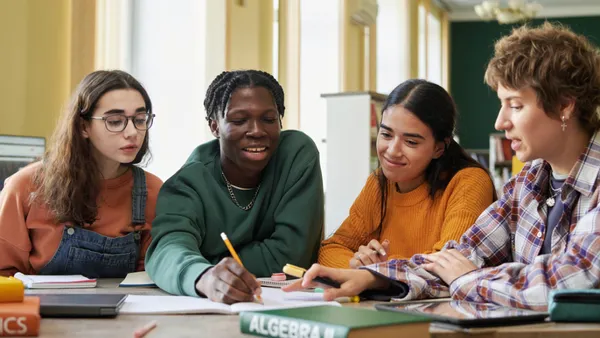Attendance on the last day of school before a holiday break can sometimes be rather spotty.
But last month, classrooms at Public Service Community High School in South Los Angeles were full, and roughly 40 representatives from local agencies and organizations were gathered in the cafeteria for instructions on what to expect during career day.
“A lot of our students, they’re going to be the first ones in their family to graduate from high school,“ Reyna Guzman, the community school coordinator at Public Service Community High School — part of a network of “partner schools” affiliated with the nonprofit Los Angeles Education Partnership (LAEP) — told the Los Angeles firefighters, engineers, healthcare professionals and other visitors seated at lunch tables.
For the rest of the morning, the featured guests circulated throughout classrooms in the building, sharing how they got into their line of work and answering students’ questions.
In one class, for example, students heard from a clinical psychologist, a Fox Sports media administrator and a former foster child who teaches hip-hop dance and works with local nonprofits to encourage other students in foster care.
In another classroom, Brandan Aldridge, an LAEP community support coordinator who also runs a nonprofit after-school basketball program, encouraged students to network with people who can have a positive influence on their lives. Dressed in sweats and a hoodie, he started off his classroom visit by slumping in his chair and appearing disinterested, but then shed that look for a more professional one.
“The streets only hold you back if you let them hold you back,” he tells the students. “If your homeboy isn’t on the same path as you, leave your homeboy behind.”
While the school has held several of these events, Principal Dennis Fulgoni and Guzman organized it earlier this year in hopes that they can invite the professionals back for a second visit and find additional opportunities to expose students to service-related careers they might not have thought of — showing how community schools are always trying to make the most of the relationships they build with community partners.
Community schools find union support
Since United Teachers Los Angeles (UTLA) began negotiating a new contract with the Los Angeles Unified School District (LAUSD) more than a year ago, the union has been advocating for more community schools like Public Service as a way to improve student performance and stem the growth of charter schools.
The union set a strike date for Jan. 10. While contract negotiations resumed Jan. 7, with Los Angeles Mayor Eric Garcetti's intervention, UTLA rejected the district's latest offer. "We don't think there was a lot of progress made today," UTLA President Alex Caputo-Pearl said in a press briefing posted on the union's Twitter account. The two sides plan to meet again on Wednesday.
Community schools are highlighted as part of the union-led Alliance to Reclaim Our Schools platform, nationally and in Los Angeles. And in a 2017 article for Center X at the University of California, Los Angeles (UCLA), Caputo-Pearl mentioned community schools in describing the union’s campaign to see the state or at least LAUSD spend $20,000 per student by 2020.
“It would mean a nurse in every school. It would mean a librarian in every school. It would mean actually having restorative justice programs, staffed with people whose job it is to help develop restorative practices,” he said. “It would mean another one of our common good proposals around investing in a community schools model. It would mean more schools with wraparound services, with real breadth of curriculum in ethnic studies, music and the arts.”
In several urban districts, teachers unions have been actively involved in supporting the community school model. Unions “provide a vehicle to quickly reach cohesiveness between schools and communities,” José Munoz, the director of the Coalition for Community Schools, wrote in an email. “That communication power helps harness and scale best practices nationally.”
In Ohio's Cincinnati Public Schools, for example, in which every school is designed as a “community learning center,” Cincinnati Federation of Teachers President Julie Sellers has been known to say, "I wouldn't teach in a school that isn't a community learning center," Darlene Kamine, executive director of the Community Learning Center Institute, wrote in an email.
She added that from the earliest discussions of implementing the model in Cincinnati, both CFT and the American Federation of Teachers were “strong and invaluable supporters.”
How community schools develop
Community schools develop in many ways, but they typically include formal partnerships in which community organizations provide schools with wraparound services such as health, mental health and after-school programs, and a separate coordinator position is created to make it all work. Unions view the strategy as a way to address many of the nonacademic issues — such as food insecurity, mental of physical health needs, or a lack of enrichment opportunities — that interfere with students’ learning.
“All of these issues walk into a classroom whether you want it or not,” Karen Alford, a vice president for the United Federation of Teachers (UFT) in New York City, said in an interview. Alford leads the union’s "community learning school” initiative in which the union is the lead community agency and pays for a full-time community school director (or coordinator) at 31 schools across the district.
While that effort is separate from the New York City Department of Education’s rapid expansion of community schools in recent years, Alford said the union and district officials work together on issues such as data and professional development.
And even before New York City Mayor Bill de Blasio was elected, UFT arranged for leading mayoral candidates to visit Cincinnati, where leaders say the community school model has contributed to growth in graduation rates and student performance.
Working to ‘energize the neighborhood’
In LAUSD, it’s unclear how many schools operate as community schools. The model gained some traction in 2007 when the district launched its “pilot schools” initiative, which encourages “community-based, teacher-driven reform,” according to a 10-year report.
Some LAEP partner schools were among those initial pilot schools. So were the Robert F. Kennedy Community Schools — a six-school K-12 complex built on the site of the former Ambassador Hotel where the senator was assassinated in 1968.
“We’re trying to create a groundswell of commitment” around community schools, Karen Quartz, the director of UCLA’s Center for Community Schooling, said in an interview. In addition to serving as the lead community agency for RFK Community Schools, the UCLA center also formed a partnership with Horace Mann Middle School to create Mann UCLA Community School.
The school, located in the vicinity of 37 charter schools, was losing enrollment until the center added a 9th grade. “The effort there is to energize the neighborhood and bring in resources,” Quartz said.
The center pays for a liaison — a coordinator-type position — at its two community schools. LAEP and the Youth Policy Institute, which oversees community schools in the Los Angeles Promise Neighborhoods, also hire the coordinators who work in their affiliated schools.
But one point of conflict between the district and the union, Quartz added, is whether coordinators should be district employees or hired by community-based organizations, as they are in many districts with community schools. She also noted that some LAUSD schools have other positions that already essentially function as a coordinator. She gave the example of counselors working as part of the district’s “A-G” Diploma Project, which focuses on supporting students in passing the courses needed for admission to the state’s two university systems.
In 2017, the LAUSD board passed a resolution endorsing the approach and encouraging more schools to “transform themselves into neighborhood hubs for children, families and civic partners.” (The district did not respond to questions about what steps officials have taken since then to expand community schools.)
But Quartz suggested that Beutner’s plan to decentralize the district into 32 local networks opens the door for more community involvement in local schools. "I feel like it’s a very viable and promising strategy for the district to take on," she said.
The question is whether a stronger community schools strategy across the district can reverse declining enrollment, as it has at Mann.
"It’s going to be this slow ripple of people getting on board or not," Quartz said, "as this neighborhood school or charter school tension plays out."












